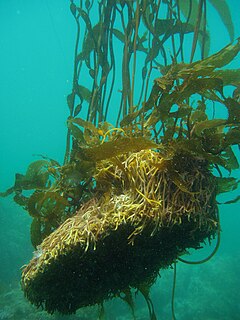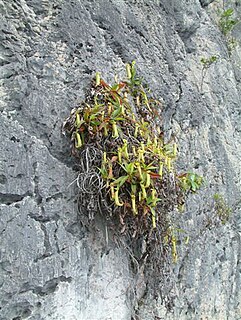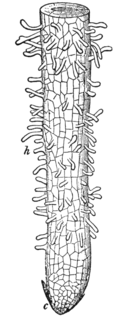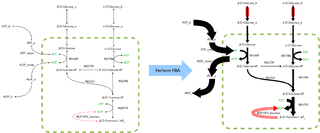Related Research Articles

Bacterial growth is proliferation of bacterium into two daughter cells, in a process called binary fission. Providing no event occurs, the resulting daughter cells are genetically identical to the original cell. Hence, bacterial growth occurs. Both daughter cells from the division do not necessarily survive. However, if the number surviving exceeds unity on average, the bacterial population undergoes exponential growth. The measurement of an exponential bacterial growth curve in batch culture was traditionally a part of the training of all microbiologists; the basic means requires bacterial enumeration by direct and individual, direct and bulk (biomass), indirect and individual, or indirect and bulk methods. Models reconcile theory with the measurements.

Plant nutrition is the study of the chemical elements and compounds necessary for plant growth, plant metabolism and their external supply. In its absence the plant is unable to complete a normal life cycle, or that the element is part of some essential plant constituent or metabolite. This is in accordance with Justus von Liebig's law of the minimum. The total essential plant nutrients include seventeen different elements: carbon, oxygen and hydrogen which are absorbed from the air, whereas other nutrients including nitrogen are typically obtained from the soil.

A holdfast is a root-like structure that anchors aquatic sessile organisms, such as seaweed, other sessile algae, stalked crinoids, benthic cnidarians, and sponges, to the substrate.

Lithophytes are plants that grow in or on rocks. They can be classified as either epilithic or endolithic; epilithic lithophytes grow on the surfaces of rocks, while endolithic lithophytes grow in the crevices of rocks. Lithophytes can also be classified as being either obligate or facultative. Obligate lithophytes grow solely on rocks, while facultative lithophytes will grow partially on a rock and on another substrate simultaneously.

A bioreactor refers to any manufactured device or system that supports a biologically active environment. In one case, a bioreactor is a vessel in which a chemical process is carried out which involves organisms or biochemically active substances derived from such organisms. This process can either be aerobic or anaerobic. These bioreactors are commonly cylindrical, ranging in size from litres to cubic metres, and are often made of stainless steel. It may also refer to a device or system designed to grow cells or tissues in the context of cell culture. These devices are being developed for use in tissue engineering or biochemical/bioprocess engineering.

Root hair, or absorbent hairs, are tubular outgrowths of an epidermal cell of a root, a hair-forming cell on the epidermis of a plant root. These structures are lateral extensions of a single cell and are only rarely branched. They are found in the region of maturation, also called the zone of differentiation of the root. Just prior to and during root hair cell development, there is elevated phosphorylase activity. Plants absorb water through the roots from the soil by bulk flow. Root hair cells are adapted to this process by increasing root surface area for the purpose of taking in more water. The large vacuole inside root hair cells makes this intake much more efficient.

Biological soil crusts are communities of living organisms on the soil surface in arid and semi-arid ecosystems. They are found throughout the world with varying species composition and cover depending on topography, soil characteristics, climate, plant community, microhabitats, and disturbance regimes. Biological soil crusts perform important ecological roles including carbon fixation, nitrogen fixation and soil stabilization; they alter soil albedo and water relations and affect germination and nutrient levels in vascular plants. They can be damaged by fire, recreational activity, grazing and other disturbances and can require long time periods to recover composition and function. Biological soil crusts are also known as biocrusts or as cryptogamic, microbiotic, microphytic, or cryptobiotic soils.
The Gompertz curve or Gompertz function is a type of mathematical model for a time series, named after Benjamin Gompertz (1779–1865). It is a sigmoid function which describes growth as being slowest at the start and end of a given time period. The right-hand or future value asymptote of the function is approached much more gradually by the curve than the left-hand or lower valued asymptote. This is in contrast to the simple logistic function in which both asymptotes are approached by the curve symmetrically. It is a special case of the generalised logistic function. The function was originally designed to describe human mortality, but since has been modified to be applied in biology, with regard to detailing populations.
The dynamic energy budget (DEB) theory is a formal metabolic theory which provides a single quantitative framework to dynamically describe the aspects of metabolism of all living organisms at the individual level, based on assumptions about energy uptake, storage, and utilization of various substances. The DEB theory adheres to stringent thermodynamic principles, is motivated by universally observed patterns, is non-species specific, and links different levels of biological organization as prescribed by the implications of energetics. Models based on the DEB theory have been successfully applied to over a 1000 species with real-life applications ranging from conservation, aquaculture, general ecology, and ecotoxicology. The theory is contributing to the theoretical underpinning of the emerging field of metabolic ecology.

Flux balance analysis (FBA) is a mathematical method for simulating metabolism in genome-scale reconstructions of metabolic networks. In comparison to traditional methods of modeling, FBA is less intensive in terms of the input data required for constructing the model. Simulations performed using FBA are computationally inexpensive and can calculate steady-state metabolic fluxes for large models in a few seconds on modern personal computers. The related method of metabolic pathway analysis seeks to find and list all possible pathways between metabolites.
The bacterium, despite its simplicity, contains a well-developed cell structure which is responsible for some of its unique biological structures and pathogenicity. Many structural features are unique to bacteria and are not found among archaea or eukaryotes. Because of the simplicity of bacteria relative to larger organisms and the ease with which they can be manipulated experimentally, the cell structure of bacteria has been well studied, revealing many biochemical principles that have been subsequently applied to other organisms.

A chemostat is a bioreactor to which fresh medium is continuously added, while culture liquid containing left over nutrients, metabolic end products and microorganisms are continuously removed at the same rate to keep the culture volume constant. By changing the rate with which medium is added to the bioreactor the specific growth rate of the microorganism can be easily controlled within limits.
An isomorph is an organism that does not change in shape during growth. The implication is that its volume is proportional to its cubed length, and its surface area to its squared length. This holds for any shape it might have; the actual shape determines the proportionality constants.
An V1-morph is an organism that changes in shape during growth such that its surface area is proportional to its volume. In most cases both volume and surface area are proportional to length
The shape correction function is a ratio of the surface area of a growing organism and that of an isomorph as function of the volume. The shape of the isomorph is taken to be equal to that of the organism for a given reference volume, so for that particular volume the surface areas are also equal and the shape correction function has value one.
Dynamic reserve, in the context of the dynamic energy budget theory, refers to the set of metabolites that an organism can use for metabolic purposes. These chemical compounds can have active metabolic functions, however. They are not just "set apart for later use." Reserve differs from structure in the first place by its dynamics. Reserve has an implied turnover, because it is synthesized from food and used by metabolic processes occurring in cells. The turnover of structure depends on the maintenance of an organism. Maintenance is not required for reserve. A freshly laid egg consists almost exclusively of reserve, and hardly respires. The chemical compounds in the reserve have the same turnover, while that in the structure can have a different turnover, and so it depends on the compound.

Bacteria are ubiquitous, mostly free-living organisms often consisting of one biological cell. They constitute a large domain of prokaryotic microorganisms. Typically a few micrometres in length, bacteria were among the first life forms to appear on Earth, and are present in most of its habitats. Bacteria inhabit soil, water, acidic hot springs, radioactive waste, and the deep biosphere of Earth's crust. Bacteria are vital in many stages of the nutrient cycle by recycling nutrients such as the fixation of nitrogen from the atmosphere. The nutrient cycle includes the decomposition of dead bodies; bacteria are responsible for the putrefaction stage in this process. In the biological communities surrounding hydrothermal vents and cold seeps, extremophile bacteria provide the nutrients needed to sustain life by converting dissolved compounds, such as hydrogen sulphide and methane, to energy. Bacteria also live in symbiotic and parasitic relationships with plants and animals. Most bacteria have not been characterised and there are many species that cannot be grown in the laboratory. The study of bacteria is known as bacteriology, a branch of microbiology.
Fed-batch culture is, in the broadest sense, defined as an operational technique in biotechnological processes where one or more nutrients (substrates) are fed (supplied) to the bioreactor during cultivation and in which the product(s) remain in the bioreactor until the end of the run. An alternative description of the method is that of a culture in which "a base medium supports initial cell culture and a feed medium is added to prevent nutrient depletion". It is also a type of semi-batch culture. In some cases, all the nutrients are fed into the bioreactor. The advantage of the fed-batch culture is that one can control concentration of fed-substrate in the culture liquid at arbitrarily desired levels.

Phototrophic biofilms are microbial communities generally comprising both phototrophic microorganisms, which use light as their energy source, and chemoheterotrophs. Thick laminated multilayered phototrophic biofilms are usually referred to as microbial mats or phototrophic mats. These organisms, which can be prokaryotic or eukaryotic organisms like bacteria, cyanobacteria, fungi, and microalgae, make up diverse microbial communities that are affixed in a mucous matrix, or film. These biofilms occur on contact surfaces in a range of terrestrial and aquatic environments. The formation of biofilms is a complex process and is dependent upon the availability of light as well as the relationships between the microorganisms. Biofilms serve a variety of roles in aquatic, terrestrial, and extreme environments; these roles include functions which are both beneficial and detrimental to the environment. In addition to these natural roles, phototrophic biofilms have also been adapted for applications such as crop production and protection, bioremediation, and wastewater treatment.
Entomoculture is a term Natalie Rubio at Tufts University coined to describe the subfield of cellular agriculture, which specifically deals with the production of insect tissue in vitro. It draws on principles more generally used in tissue engineering and has many scientific similarities to Baculovirus Expression Vectors or soft robotics. The field has mainly been proposed because of its potential technical advantages over mammalian cells in generating cultivated meat.
References
- ↑ Kooijman SA (March 2001). "Quantitative aspects of metabolic organization: a discussion of concepts". Philosophical Transactions of the Royal Society B. 356 (1407): 331–349. doi:10.1098/rstb.2000.0771. PMC 1088431 . PMID 11316483.